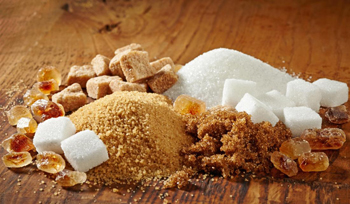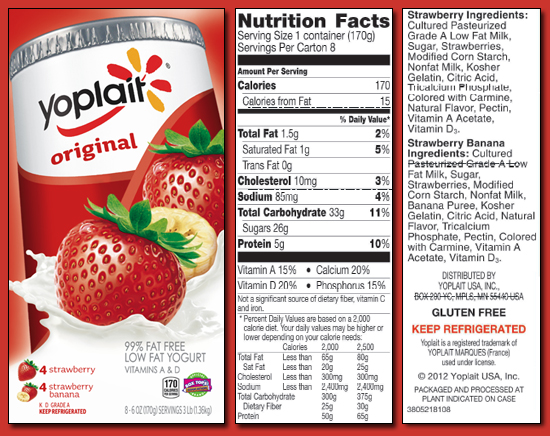There are many names of sugar. There is a lot of added sugar in processed foods. Manufactures often use several kinds of sugar so they can hide the actual amount of sugar in a food item because the rules the FDA requires for food labels require manufacturers to list ingredients by weight. If food makers relied on only a few types of sugar to sweeten and preserve their foods than sugar would appear in the top 3 ingredients and health conscious people and parents would think twice before buying their items. By creating so many names for sugar they can keep the weight of ingredients down so the names of the ingredients can be lower on the label…and make it more difficult for people to recognize how much sugar they are eating when they consume processed foods.
The Difference Between Glucose and Fructose
 Glucose is more friendly to our system and can be metabolized by most cells in our bodies. Fructose is mainly processed in our liver. While it is a good idea to minimize our sugar consumption, it is especially beneficial to avoid foods high in fructose. There are many harmful effects of consuming high fructose, including insulin resistance, metabolic syndrome, fatty liver and type 2 diabetes.
Glucose is more friendly to our system and can be metabolized by most cells in our bodies. Fructose is mainly processed in our liver. While it is a good idea to minimize our sugar consumption, it is especially beneficial to avoid foods high in fructose. There are many harmful effects of consuming high fructose, including insulin resistance, metabolic syndrome, fatty liver and type 2 diabetes.
Names for Sugar
Most sugars contain a blend of Glucose and Fructose. Some sweeteners contain either pure Glucose or Glucose with sugars other than fructose. There are a few sweeteners that are less common but still used that contain neither Glucose or Fructose.
This list of 75 names of sugar include the reference G/F for a blend of Glucose and Fructose, G for Glucose without Fructose, F for only Fructose, and O for sugars that don’t contain G/F.
- Agave Nectar G/F
- Barbados Sugar G/F
- Barley Malt G
- Barley Malt Syrup G/F
- Beet Sugar G/F
- Blackstrap Molasses G/F
- Brown Sugar G/F
- Brown Rice Syrup G
- Buttered Syrup G/F
- Cane Juice G/F
- Cane Juice Crystals G/F
- Cane Sugar G/F
- Caramel G/F
- Carob Syrup G/F
- Castor Sugar G/F
- Coconut Palm Sugar G/F
- Coconut Sugar G/F
- Confectioner’s Sugar (Powered Sugar) G/F
- Corn Sweetener G/F
- Corn Syrup G
- Corn Syrup Solids G
- Crystalline Fructose F
- Date Sugar G/F
- Dehydrated Cane Juice G/F
- Demerara Sugar G/F
- Dextrin G
- Dextrose G
- Diastatic Malt G
- D-ribose O
- Ethyl Maltol G
- Evaporated Cane Juice G/F
- Florida Crystals G/F
- Free-Flowing Brown Sugars G/F
- Fructose F
- Fruit Juice G/F
- Fruit Juice Concentrate G/F
- Galactose O
- Golden Sugar G/F
- Golden Syrup G/F
- Glucose G
- Glucose Solids G
- Grape Sugar G/F
- High-Fructose Corn Syrup G/F
- Honey G/F
- Icing Sugar G/F
- Invert Sugar G/F
- Jaggery G/F
- Kokuto G/F
- Lactose G
- Maltodextrin G
- Maltol G/F
- Maltose G
- Malt Syrup G
- Mannose G/F
- Maple Syrup G/F
- Molasses G/F
- Muscovado Sugar G/F
- Palm Sugar G/F
- Panela Sugar G/F
- Panocha G/F
- Piloncillo G/F
- Rapadura G/F
- Raw Sugar G/F
- Refiner’s Syrup G/F
- Rice Syrup G
- Saccharose G/F
- Sorghum Syrup G/F
- Sucrose G/F
- Sucanat G/F
- Sugar (granulated) G/F
- Sweet Sorghum G/F
- Syrup G/F
- Treacle Sugar G/F
- Turbinado Sugar G/F
- Yellow Sugar G/F
Sucrose occurs naturally in many fruits and plants. It commonly referred to as table sugar. It made from sugar cane or sugar beets and consists of 50% glucose and 50% fructose bound together.
 High-Fructose Corn Syrup comes from industrial processed corn starch. There are several types of HFCS with varied amounts of fructose, two types are HFCS 55 which contains 55% fructose and 45% glucose (the most common) and HFCS 90 with contains 90% fructose.
High-Fructose Corn Syrup comes from industrial processed corn starch. There are several types of HFCS with varied amounts of fructose, two types are HFCS 55 which contains 55% fructose and 45% glucose (the most common) and HFCS 90 with contains 90% fructose.
Agave Nectar or syrup is from the agave plant. it contains 70-90% fructose and 10-30% glucose. It is viewed as a healthy alternate to some sweeteners because it doesn’t spike blood sugar levels as quickly as some sugars, however because of it’s high fructose level it may be less healthy than regular sugar.
Sugar comes by many names and being mindful of our sugar intake is always a good choice when we are choosing wellness. Naturally occurring sugars in fruits and vegetables are always the best choice because they contain other nutrients and fiber that help us maintain our health. The best way to reduce our sugar intake is to avoid processed foods. Yes, that means bottled sauces and dressings, anything in a box or in the snack isle. It also means that it will take a bit more to create your menu but you are worth it!
I hope this article helps Fuel Your Wellness. Please leave your comments below.
Resources & Start Learning More at:
 Summer D Clemenson co-owns Clemenson Enterprises and Wellness Works NW with her wife, Karen G Clemenson. Their personal motto is Creativity, Honesty & Positivity are a must! This mantra helps them stay community and wellness minded in all they do. Summer also writes poetry and inspirational blogs @ ClemensonEnterprises.com. Her crochet art can be viewed and purchased @ KnottyWares.com & she loves special orders!
Summer D Clemenson co-owns Clemenson Enterprises and Wellness Works NW with her wife, Karen G Clemenson. Their personal motto is Creativity, Honesty & Positivity are a must! This mantra helps them stay community and wellness minded in all they do. Summer also writes poetry and inspirational blogs @ ClemensonEnterprises.com. Her crochet art can be viewed and purchased @ KnottyWares.com & she loves special orders!



 Please wait...
Please wait...

